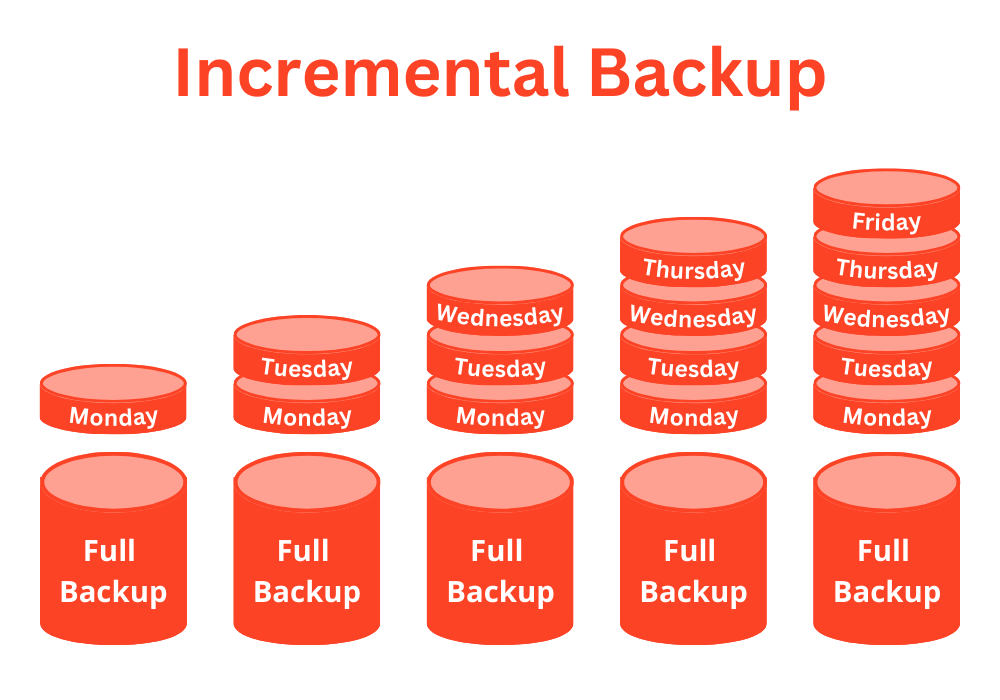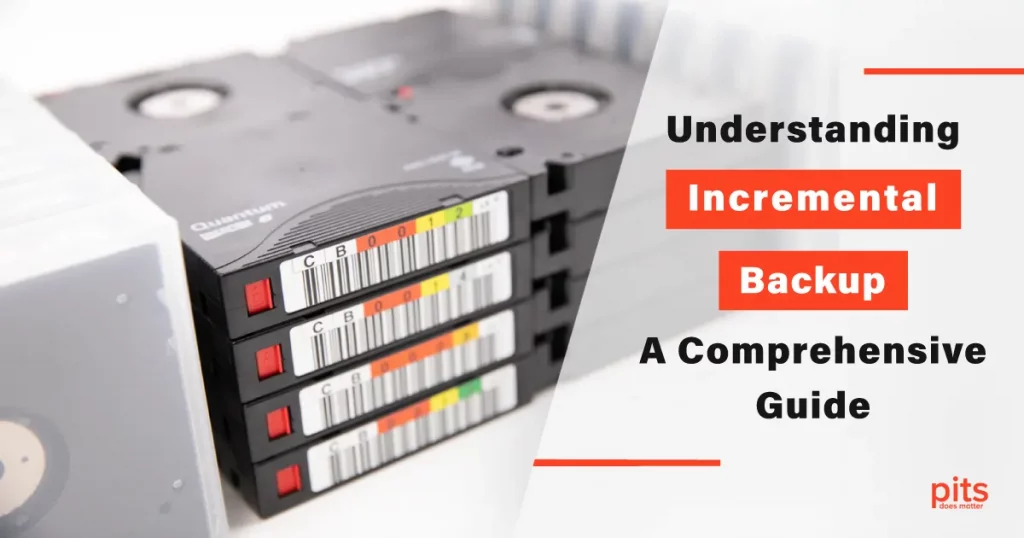Incremental backup is a data backup method that saves only the changes made since the last backup, ensuring efficient storage and retrieval of information. Rather than creating a full backup every time, incremental backups only copy and save new or modified files, reducing the amount of data being transferred and stored. This method enables efficient use of storage resources and reduces the overall time taken for backups.
Understanding Incremental Backup starts with recognizing its primary function: saving only the changes made since the last backup, whether full or incremental. This method ensures efficient use of storage resources and reduces the time taken to perform the backup, thus proving itself to be a crucial tool in data preservation strategies.
How Incremental Backups Work
How Incremental Backups Work – These backups commence by creating a full data backup. Incremental backup is a backup strategy that involves backing up only the data that has changed or been created since the last backup, whether an incremental or full backup. It identifies and saves the differences between the current data and the previous backup. This approach significantly reduces the time and resources needed for backups, making it an attractive option for organizations of all sizes.
To better understand how incremental backups work, let’s consider a hypothetical scenario:
Full Backup (Level 0)
The first backup taken is a full backup, which captures all the data at a specific point in time. This serves as the baseline for future backups.
Incremental Backup (Level 1)
After the initial full backup, incremental backups are taken at regular intervals (e.g., daily or weekly). These backups only store the changes made to the data since the last backup. For example, if a file is modified, only the modified parts will be saved in the incremental backup.
Subsequent Incremental Backups
The process continues with subsequent incremental backups. Each incremental backup is linked to the previous one, forming a chain of backups.

Advantages of Incremental Backups
Advantages of Incremental Backups include conserving storage space since they only store changes made since the last backup and not the entire dataset. This method also reduces the time required for each backup operation, enabling more frequent backups and a reduced recovery time objective (RTO). Furthermore, it lowers the burden on network resources, making it an ideal solution for businesses with vast amounts of data. The incremental backup method offers several compelling advantages over other backup strategies:
Faster Backups
Since only the changed or new data is backed up, incremental backups are generally much faster than full backups. This efficiency becomes even more pronounced as the dataset grows, saving time and resources.
Faster Restore Time
When data needs to be restored, the process becomes more efficient. Only the last full backup and the latest incremental backup must be applied to restore the most recent data, significantly reducing the time required for data recovery.

Less Storage Space
Incremental backups take up less than full or differential backups. This can be particularly advantageous when storage costs are a concern.
Disaster Recovery
Incremental backups are crucial to a comprehensive disaster recovery plan. In the event of data loss or system failure, multiple incremental backups allow organizations to restore data to specific points, minimizing data loss.
Disadvantages of Incremental Backups
Disadvantages of incremental backups include a more complex recovery process as it involves restoring data from the latest full backup and all following incremental backups. This method can also lead to longer recovery times if multiple incremental backups need to be processed. Furthermore, if any backup in the chain is damaged or lost, it can render later backups useless, posing a potential risk to data integrity. While incremental backups offer many benefits, they are not without their drawbacks:

Dependency on Previous Backups
Restoring data from incremental backups requires access to the last full backup and all intermediate incremental backups. The restore process may be compromised if any backups are corrupted or missing.
Complex Restore Process
The restore process from incremental backups can become more complex, especially when multiple incremental backups are involved in a chain. Proper management and organization of backup files are essential to ensure a smooth restore experience.
Potential Data Loss
In cases where an incremental backup is missed or fails to execute correctly, data changes made since the last backup may be lost. It is crucial to ensure that backup schedules are properly maintained and monitored.
Types of Incremental Backups
Types of Incremental Backups are primarily categorized into two: Differential and Cumulative. Differential Incremental Backups save the changes made since the last full backup, meaning each backup will have more data than the previous.
Cumulative Incremental Backup
In this type, each incremental backup contains all changes made since the last full backup. As incremental backups grow, the restore process can become slower.
Differential Incremental Backup
Differential backups only capture the changes made since the last incremental backup, not the last full backup. This approach can speed up the restore process, but each differential backup may become larger over time.
Incremental Forever Backup
This method performs regular incremental backups indefinitely without periodic full backups. It strikes a balance between faster backups and manageable restore times.
Incremental backup is a powerful and efficient data protection strategy that offers faster backups, quicker restore times, and reduced storage space. While it has drawbacks, proper planning and execution can mitigate these concerns. As part of a comprehensive backup strategy, incremental backups ensure data safety and facilitate disaster recovery. Organizations can safeguard their data and confidently continue their operations by understanding how incremental backups work and selecting the right backup system.
Frequently Asked Questions
What is an incremental backup?
An incremental backup is a type of data backup method that captures and stores only the changes made to files and data since the last backup, be it a full backup or a previous incremental backup. It aims to minimize backup time and storage requirements by focusing on recent modifications.
How does incremental backup differ from full backup?
A full backup (level 0) copies and stores all data at a specific point in time, while an incremental backup only saves the changes made since the last backup. Full backups are more time-consuming and require more storage space, whereas incremental backups are faster and smaller.
How does incremental backup work?
Incremental backups work by creating a chain of backups, starting with a full backup. Each subsequent incremental backup captures the changes made since the previous backup. During data restoration, all the backups in the chain are applied in chronological order, ensuring the data is restored to its most recent state.
What are the advantages of incremental backups?
Incremental backups offer faster backup times, reduced storage requirements, and quicker data restoration compared to full backups. These advantages make incremental backups ideal for organizations that need to back up their data frequently and efficiently.
